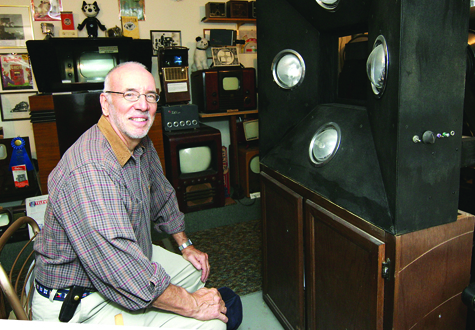Cutchogue man collects TV history

“Hey, kids, what time is it?”
If you’re an adult of a certain age, you know the answer: “It’s Howdy Doody time.” The kids show ran on NBC from 1947 to 1960 and was one of the few commercial television programs available in many markets in the late 1940s and early 1950s.
Memorabilia about the show is one small part of the television history amassed by Nassau Point resident Richard Brewster, 72. His collection of printed memorabilia and early television sets, radio receivers and wireless telephones fills a room in his house.
“This hobby has been an awful lot of fun,” Mr. Brewster said.
He purchased some of his collection from an elderly man he heard about through his hunt for collectibles. He can’t estimate the worth of his collection today. And after more than 40 years acquiring bits and pieces of radio and TV history, Mr. Brewster said he wants nothing more because any new additions would be redundant.
His hobby was not just about hardware and memorabilia, he said. He also built a substantial library on which he relies to write his regular history columns for the Antique Wireless Association Journal.
While many think television started in the wake of an exhibit at the 1939 World’s Fair, Mr. Brewster knows that the initial effort to transmit pictures electronically occurred back in 1884. In the days of the telegraph, Paul Nipkow patented a device that systematically scanned images into elemental points we today call pixels.
“Television was too complex for one man to invent it,” Mr. Brewster said. Along the way came many other inventors who built on Mr. Nipkow’s idea, he explained.
But it wasn’t until 1928 that the technology went beyond laboratory experiments. That year, in Schenectady, N.Y., General Electric radio station WGY telecast a play called “The Queen’s Messenger” for an audience of scientists and newsmen, using a mechanical system for both transmitting and receiving sound and pictures.
That showing occurred on Sept. 11, only 73 years to the day before the world would be glued to the television watching the horror of terrorist attacks in the United States.
Back in 1969, Mr. Brewster, a nuclear power engineer who worked overseas in Czechoslovakia, England, Japan, Korea, as well as in the United States, told his wife, Susan, he wanted to have an antique radio. He acquired one made in 1929 and it became the first piece in his expansive collection.
Mr. Brewster’s collection includes old TV Guide magazines and photographs, including one from 1901 showing the shortwave installation on board the USS Baltimore, one of the first ships with wireless communications. His collection includes a crystal radio from England used during World War I; early wireless communicators that were the precursor to today’s cell phones, but had limited transmission capabilities and weighed as much as 10 pounds; and picture tubes used in early TV sets in the 1940s and 1950s.
Mr. Brewster built a television camera identical to one used by the “Original Television Girl,” stage actress Natalie Towers, who appeared on CBS W2XAB beginning in July 1931. When CBS first tapped her for the job, her questions was, “What’s television?”
Mr. Brewster, who interviewed Ms. Towers several years ago, demonstrated how the actress would sit in front of the camera as a large disc with tiny pinpoint holes rotated, allowing arcs of powerful light to filter through. She saw an ongoing series of what looked like small lightning bolts flickering upward. The disc on the camera and a similar disc on the receiver had to be synchronized to create the picture.
Advertisements told the public they could now see as well as hear their favorite radio programs. Technology was rudimentary, but people were fascinated and would spend $69.50, a handsome sum in Depression era 1930, to purchase receivers, Mr. Brewster said.
As for really seeing Ms. Towers as she sang and danced, “That was not true,” Mr. Brewster said. What the public saw was a silhouette or a glimpse of a tiny, fuzzy image. Early pictures were transmitted in red and black, not black and white. Ms. Towers had to use a great deal of makeup to accentuate features that would otherwise be totally blurred, Mr. Brewster said.
One prized piece in Mr. Brewster’s collection is a television set he believes belonged to Gen. David Sarnoff, the radio and TV pioneer who founded NBC. The general’s name is scribbled on the back of the chassis, a practice repairmen used to ensure sets they took to their shops got returned to the proper customers.
Another piece that won a prize from the Antique Wireless Association for Mr. Brewster is a British-built radio sent by a collector there who feared keeping it because its face mirrored the design of the Japanese rising sun battle flag. British sentiments against the Japanese were strong after World War II and complaints about the design resulted in the manufacturer pulling the radios from shelves.
He happens to own the Japanese battle flag that some people saw in the radio design. The Brewsters received it when they climbed Japan’s Mount Fuji years ago. He keeps it with the radio to show how similar its face is to the rising sun design.


